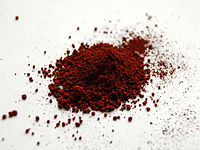
Photo from wikipedia
In a search for novel antimicrobial metal-based therapeutic agents, mononuclear gold(III) complexes 1-7 of the general formula [AuCl3(azole)], where azole stands for imidazole (im, 1), 1-isopropylimidazole (ipim, 2), 1-phenylimidazole (phim,… Click to show full abstract
In a search for novel antimicrobial metal-based therapeutic agents, mononuclear gold(III) complexes 1-7 of the general formula [AuCl3(azole)], where azole stands for imidazole (im, 1), 1-isopropylimidazole (ipim, 2), 1-phenylimidazole (phim, 3), clotrimazole (ctz, 4), econazole (ecz, 5), tioconazole (tcz, 6) and voriconazole (vcz, 7) were synthesized, characterized and biologically evaluated. In all complexes, the corresponding azole ligand is monodentately coordinated to the Au(III) via the imidazole or triazole nitrogen atom, while the remaining coordination sites are occupied by chloride anions leading to the square-planar arrangement. In vitro antimicrobial assays showed that the complexation of inactive azoles, imidazole, 1-isopropylimidazole and 1-phenylimidazole, to the Au(III) ion led to complexes 1-3, respectively, with moderate activity against the investigated strains and low cytotoxicity on the human normal lung fibroblast cell line (MRC-5). Moreover, gold(III) complexes 4-7 with clinically used antifungal agents clotrimazole, econazole, tioconazole and voriconazole, respectively, have, in most cases, enhanced antimicrobial effectiveness relative to the corresponding azoles, with the best improvement achieved after complexation of tioconazole (6) and voriconazole (7). The complexes 4-7 and the corresponding antifungal azoles inhibited the growth of dermatophyte Microsporum canis at 50 and 25 μg mL-1. Gold(III) complexes 1-3 significantly reduced the amount of ergosterol in the cell membrane of Candida albicans at the subinhibitory concentration of 0.5 × MIC (minimal inhibitory concentration), while the corresponding imidazole ligands did not significantly affect the ergosterol content, indicating that the mechanism of action of the gold(III)-azole complexes is associated with inhibition of ergosterol biosynthesis. Finally, complexes 5 and 6 significantly reduced the production of pyocyanin, a virulence factor in Pseudomonas aeruginosa controlled by quorum sensing, and increased cell survival after exposure to this bacterium. These findings could be of importance for the development of novel gold(III)-based antivirulence therapeutic agents that attenuate virulence without pronounced effect on the growth of the pathogens, offering a lower risk for resistance development.
Journal Title: Dalton transactions
Year Published: 2022
Link to full text (if available)
Share on Social Media: Sign Up to like & get
recommendations!